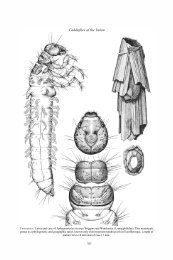Spiders of the Yukon - Department of Biological Sciences
Spiders of the Yukon - Department of Biological Sciences
Spiders of the Yukon - Department of Biological Sciences
Create successful ePaper yourself
Turn your PDF publications into a flip-book with our unique Google optimized e-Paper software.
94 C.D. Dondale et al.<br />
185. Hahnia cineria Emerton Nearctic, Boreal<br />
Distribution: Alaska to Newfoundland, south to Washington, Utah, Mexico, and Florida.<br />
<strong>Yukon</strong> records: North Fork Pass, Ogilvie Mts.<br />
<strong>Biological</strong> information: In plant litter in woods and bogs.<br />
186. Hahnia glacialis Soerensen Nearctic-West Beringian,<br />
Subarctic/Alpine<br />
Distribution: Alaska to Greenland and nor<strong>the</strong>rn New England, south to Colorado; Siberia (Eskov 1985).<br />
<strong>Yukon</strong> records: km 82 and 465 Dempster Hwy.; Old Crow; Eagle R.<br />
<strong>Biological</strong> information: In plant litter, and among stones above treeline.<br />
187. Hahnia inornata Chamberlin and Ivie Cordilleran, Subarctic/Alpine<br />
Distribution: Nor<strong>the</strong>rn British Columbia southward in <strong>the</strong> Cordillera to New Mexico, with an outlier<br />
in Arizona.<br />
<strong>Yukon</strong> records: Cultus Bay and Christmas Bay, Kluane National Park; Carmacks.<br />
<strong>Biological</strong> information: In plant litter.<br />
Taxonomic notes: Hahnia inornata was treated as a junior synonym <strong>of</strong> H. ononidum Simon by Opell<br />
and Beatty (1976), but we doubt <strong>the</strong> validity <strong>of</strong> this synonymy.<br />
188. Neoantistea magna (Keyserling) Nearctic, Boreal<br />
Distribution: Alaska to Newfoundland, south to nor<strong>the</strong>rn California, Colorado, and Florida.<br />
<strong>Yukon</strong> records: Old Crow; Slims R. delta.<br />
<strong>Biological</strong> information: In litter under deciduous shrubs and trees.<br />
Family Pisauridae<br />
Pisaurids are called nurseryweb spiders because <strong>of</strong> <strong>the</strong> tent-like nursery in which <strong>the</strong><br />
female suspends <strong>the</strong> egg sac as hatching approaches. The female “stands guard” on <strong>the</strong><br />
outside <strong>of</strong> <strong>the</strong> nursery, and <strong>the</strong> young disperse into a solitary hunting mode <strong>of</strong> life. The<br />
habitats are <strong>the</strong> margins <strong>of</strong> lakes or ponds, and <strong>the</strong>se spiders can hunt under water. A single<br />
species is known from <strong>the</strong> <strong>Yukon</strong>.<br />
189. Dolomedes triton (Walckenaer) Nearctic, Boreal<br />
Distribution: Sou<strong>the</strong>rn Alaska and western Northwest Territories to Maine, south to Mexico and Cuba.<br />
<strong>Yukon</strong> records: Koidern, km 1874 Alaska Hwy.<br />
<strong>Biological</strong> information: At <strong>the</strong> edges <strong>of</strong> ponds, lakes, and <strong>the</strong> quieter parts <strong>of</strong> rivers and streams.<br />
Family Lycosidae<br />
The lycosids, or wolf spiders, are mainly dark-bodied, strong-legged hunters on <strong>the</strong><br />
ground. They have fairly sensitive vision, and <strong>the</strong>y ei<strong>the</strong>r “sit and wait” for moving prey or<br />
<strong>the</strong>y simply run it down. The females carry <strong>the</strong>ir egg sacs about on <strong>the</strong> spinnerets till hatching<br />
time, <strong>the</strong>n carry <strong>the</strong> young on <strong>the</strong>ir backs for a time. Well represented in <strong>the</strong> <strong>Yukon</strong>, <strong>the</strong> wolf<br />
spiders number 30 species, or about 10% <strong>of</strong> <strong>the</strong> <strong>Yukon</strong> total.<br />
190. Alopecosa aculeata (Clerck) Holarctic, Boreal<br />
Distribution: Alaska to Newfoundland, south to Arizona and Connecticut; Europe, Asia.<br />
<strong>Yukon</strong> records: Numerous localities from sou<strong>the</strong>rn border to Old Crow and km 141 Dempster Hwy.<br />
<strong>Biological</strong> information: In meadows and sunny woods.<br />
191. Alopecosa hirtipes (Kulczy:ski) Nearctic-West Beringian, Arctic<br />
Distribution: Nor<strong>the</strong>rn Alaska to nor<strong>the</strong>rn Labrador; eastern Siberia.<br />
<strong>Yukon</strong> records: Firth R.; Old Crow.<br />
<strong>Biological</strong> information: Among lichens on tundra.<br />
192. Alopecosa pictilis (Emerton) Nearctic-West Beringian,<br />
Subarctic/Alpine<br />
Distribution: Alaska to Labrador, south to Mt. Washington, New Hampshire; nor<strong>the</strong>rn Siberia.<br />
<strong>Yukon</strong> records: Old Crow; British Mts.; Trout L.<br />
<strong>Biological</strong> information: Among lichens on tundra.

















